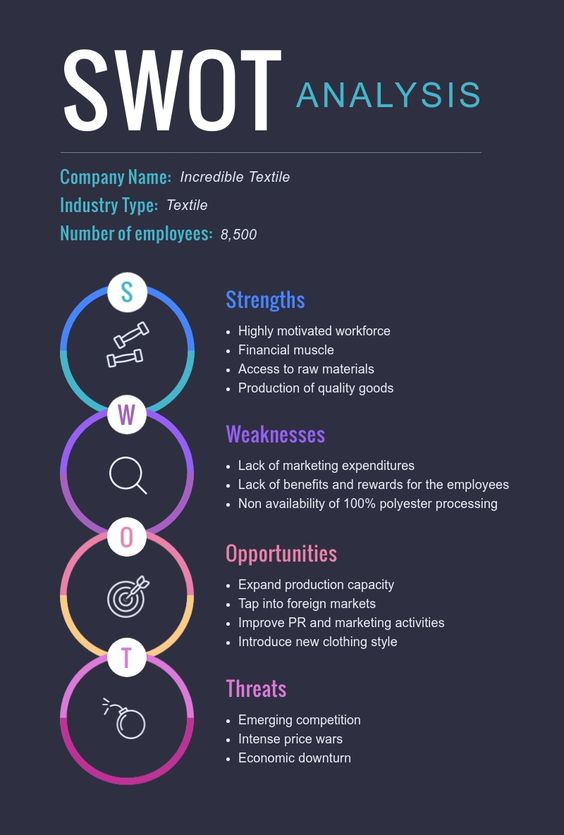When it comes to running a successful healthcare organization, it’s important to understand your strengths and weaknesses, as well as the opportunities and threats present in the industry. One of the best ways to analyze these factors is by conducting a SWOT analysis. In this article, we’ll explore 8 SWOT analysis examples specifically tailored to the healthcare industry.
SWOT Analysis Example 1: Hospital
A hospital can use a SWOT analysis to assess their strengths in specialized care, reputation, and availability of technology, but also identify weaknesses such as insufficient staffing or high turnover rates. Additionally, it can evaluate opportunities such as new government policies and funding, as well as potential threats such as competing facilities or regulatory changes.
SWOT Analysis Example 2: Private Practice
A private practice can use a SWOT analysis to identify its strengths, weaknesses, opportunities, and threats in the healthcare market. This could include areas such as staff training, office location and convenience, and access to the latest technology. They can also look for opportunities to expand their services or invest in new technology to improve patient care.
SWOT Analysis Example 3: Insurance Company
Insurance companies can use a SWOT analysis to determine their strengths in offering competitive pricing and outstanding customer service. They can also evaluate areas where they may be weak, such as technology and innovative solutions. Additionally, they can look for opportunities to offer new products or expand into new markets and identify threats such as regulatory changes, competition, and changes in customer preferences.
SWOT Analysis Example 4: Medical Device Company
Medical device companies can use a SWOT analysis to assess their strengths in product development, technology advancement, and distribution. They may also identify areas of weakness, such as research and development, manufacturing capabilities, or regulatory compliance. They can look for opportunities to expand their market reach or offer new products, while identifying possible threats such as competing devices or slow-moving regulatory processes.
SWOT Analysis Example 5: Pharmaceutical Company
Pharmaceutical companies can use a SWOT analysis to assess their strengths in drug development, research capabilities, and their reputation in the market. They can also identify areas where they may be weak such as pricing and manufacturing costs. Opportunities to expand into new markets or research new drugs can be evaluated, while potential threats could include regulatory changes or patent expirations.
SWOT Analysis Example 6: Long-term Care Facility
Long-term care facilities can use a SWOT analysis to identify their strengths in providing specialized care and services for patients. They can also evaluate areas of weakness, such as hiring and retaining highly qualified staff or managing costs. Opportunities to expand or improve services can be evaluated, while threats may include competitors entering the market or changes in government funding.
SWOT Analysis Example 7: Non-profit Organization
Non-profit healthcare organizations can use a SWOT analysis to assess their strengths in providing meaningful programs and services, as well as their reputation in the community. They can also identify areas of weakness such as lack of funding, limited volunteer support, or limited administrative resources. Opportunities for expansion or collaboration with other organizations can be identified, while threats could include reduced government funding or changes in tax laws.
You might find these FREE courses useful
- Free SWOT Analysis Tutorial
- Using Advanced SWOT Analysis
- Foundations of Business Strategy
- International Business Environment
- Supply Market Analysis
SWOT Analysis Example 8: Mental Health Clinic
Mental health clinics can use a SWOT analysis to identify their strengths in providing specialized services and their reputation in the community. They can also identify areas of weakness such as limited funding or resources to provide certain services. Opportunities to expand services, partner with other organizations, or take on new patients can be evaluated, while threats may include competing facilities or regulatory changes.
In conclusion, a SWOT analysis is a valuable tool for any healthcare organization looking to assess their strengths, weaknesses, opportunities, and threats in the industry. By conducting a SWOT analysis, healthcare organizations can develop strategies and action plans to grow, improve, and remain competitive in the ever-changing healthcare landscape.
